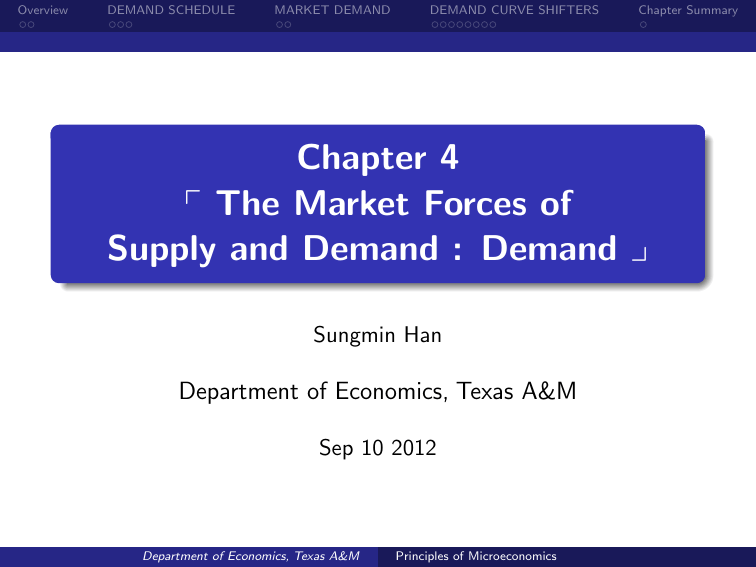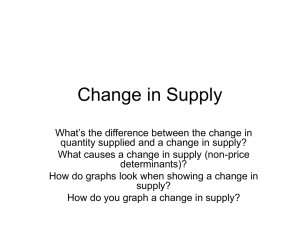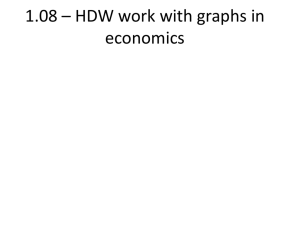Chapter 4 p The Market Forces of Department of Economics, Texas A&M

Chapter 4
p
The Market Forces of
Supply and Demand : Demand
y
Sungmin Han
Department of Economics, Texas A&M
Sep 10 2012
Department of Economics, Texas A&M
Look for the Answers to These Questions
What factors affect buyers’ demand for goods?
What factors affect sellers’ supply of goods?
How do supply and demand determine the price of a good and the quantity sold?
How do changes in the factors that affect demand or supply affect the market price and quantity of a good?
How do markets allocate resources?
Department of Economics, Texas A&M
Markets and Competition
A market is a group of buyers and sellers of a particular product.
A competitive market is one with many buyers and sellers, each has a negligible effect on price.
In a perfectly competitive market:
All goods exactly the same
Buyers & sellers so numerous that no one can affect market price - each is a “ price taker ”
In this chapter, we assume markets are perfectly competitive.
Department of Economics, Texas A&M
Demand
The quantity demanded of any good is the amount of the good that buyers are willing and able to purchase.
Law of demand : the claim that the quantity demanded of a good falls when the price of the good rises, other things equal
Department of Economics, Texas A&M
Helen’s Demand Schedule for Lattes
Demand schedule : a table that shows the relationship between the price of a good and the quantity demanded
Notice that Helen’s preferences obey the Law of Demand.
Figure 1: Helen’s Demand Schedule
Department of Economics, Texas A&M
Helen’s Demand Schedule & Curve
Figure 2: Helen’s Demand Schedule & Curve
Department of Economics, Texas A&M
Market Demand vs. Individual Demand
The quantity demanded in the market is the sum of the quantities demanded by all buyers at each price.
Suppose Helen and Ken are the only two buyers in the Latte market. ( Q d
= quantity demanded)
Figure 3: Market Demand
Department of Economics, Texas A&M
The Market Demand Curve for Lattes
Figure 4: Market Demand Curve
Department of Economics, Texas A&M
Demand Curve Shifters
The demand curve shows how price affects quantity demanded, other things being equal.
These “other things” are non-price determinants of demand
(i.e., things that determine buyers’ demand for a good, other than the good’s price).
Changes in them shift the D curve . . .
Department of Economics, Texas A&M
Demand Curve Shifters: # of Buyers
Increase in # of buyers increases quantity demanded at each price, shifts D curve to the right.
Department of Economics, Texas A&M
Demand Curve Shifters: # of Buyers
Figure 5: Demand Curve Shift
Department of Economics, Texas A&M
Demand Curve Shifters: Income
Normal good :
Demand for a normal good is positively related to income.
Increase in income causes increase in quantity demanded at each price, shifts D curve to the right.
Inferior good :
Demand for an inferior good is negatively related to income.
An increase in income shifts D curves for inferior goods to the left.
Department of Economics, Texas A&M
Demand Curve Shifters: Prices of Related Goods I
Two goods are substitutes if an increase in the price of one causes an increase in demand for the other.
Example: pizza and hamburgers.
An increase in the price of pizza increases demand for hamburgers, shifting hamburger demand curve to the right.
Other examples:
Coke and Pepsi, laptops and desktop computers, CDs and music downloads
Department of Economics, Texas A&M
Demand Curve Shifters: Prices of Related Goods II
Two goods are complements if an increase in the price of one causes a fall in demand for the other.
Example: computers and software.
If price of computers rises, people buy fewer computers, and therefore less software. Software demand curve shifts left.
Other examples: college tuition and textbooks, bagels and cream cheese, eggs and bacon
Department of Economics, Texas A&M
Demand Curve Shifters: Tastes
Anything that causes a shift in tastes toward a good will increase demand for that good and shift its D curve to the right.
Example:
The Atkins diet became popular in the ’90s, caused an increase in demand for eggs, shifted the egg demand curve to the right.
Department of Economics, Texas A&M
Demand Curve Shifters: Expectations
Expectations affect consumers’ buying decisions.
Examples:
If people expect their incomes to rise, their demand for meals at expensive restaurants may increase now.
If the economy sours and people worry about their future job security, demand for new autos may fall now.
Department of Economics, Texas A&M
Summary : Variables That Influence Buyers
Figure 6: Variables That Influence Buyers
Department of Economics, Texas A&M





